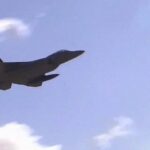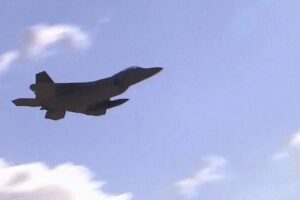Calling a US P-8 spy plane patrol through the Taiwan strait a “threat to China’s security,” a People’s Republic of China government-backed newspaper has published a bilingual audio recording of a warning to the US aircraft along with instructions to immediately turn around.
Following comments in Chinese, the published audio recording says “US aircraft, this is the PLA Air Force, you are approaching Chinese territorial (airspace). Please reverse course or you will be intercepted.”
“A US P-8A anti-submarine patrol aircraft on Thursday transited through the Taiwan Straits, and the PLA Eastern Theater Command deployed combat aircraft to track and monitor it throughout its entire course in accordance with laws and regulations, Senior Colonel Shi Yi, a spokesperson for the PLA Eastern Theater Command, said,” as stated in the PRC-backed Global Times.
The Chinese paper did quote a statement from US Seventh Fleet saying the “US is committed to a free and open Pacific.”
While the Chinese paper published the audio recording, it is not clear if it came from a fighter jet, surveillance plane or ground command center of some kind, and it may be unclear as to whether the P-8 crew actually “heard” the warning. Regardless, Taiwan is 100 miles away from the Chinese mainland coast so there are many miles of international airspace in the Taiwan strait which the US does at times patrol.
US military aircraft and surface ship regularly conduct security and stability patrols throughout the Pacific, to include areas in the South China Sea, Japan and in and around Taiwan. Pentagon leaders have for many years now said the US will operate where they need to according to international law.
Years ago, the US Navy conducted Freedom of Navigation Operations (FONOPS) to send a message countering what the Pentagon considers illegal territorial claims and phony island building (land reclamation) in the region. By sailing within the 12 mile territorial boundary surrounding islands and land areas, established by the International Law of the Sea Convention, the US military is clearly seeking to make a clear and unambiguous statement that the disputed South China Sea territory does not belong to China. The area in and around the South China Sea, part of which is the disputed Spratly Islands, includes island territories claimed by several Southeast Asian countries and is not owned by the PRC.
This context is important because, years ago, it was a US Navy P-8 aircraft which obtained video verification of Chinese “island building” in the South China Sea, an overt effort to claim and expand disputed territory as Chinese. Going back many years, the Chinese government has claimed territorial ownership of most if not all of the South China Sea according to what it calls its “nine-dash-line.” This claim has never been considered legitimate by the Pentagon and its Pacific allies. Given this, it would make sense to operate P-8s in international airspace in the Pacific for security reasons and to monitor what the Pentagon considers illegal land reclamation and phony territorial claims. P-8 surveillance aircraft, patrolling in international airspace in the Taiwan strait and throughout the Pacific, can help safeguard Taiwan from a surprise Chinese amphibious assault or submarine attack.
The Pentagon maintains a similar strategy with its air assets in the Pacific, as the US Air Force Pacific Command regularly conducts Bomber Task Force patrols in international air space throughout the Pacific as well. The intent is to demonstrate readiness and resolve to deter any potential Chinese aggression.
What is significant about the Chinese warning is the apparent inconsistency, as Chinese aircraft are increasing their violations of Taiwan’s Air Defense Identification Zone (ADIZ) and airspace to intimidate the island and emphasize its “one-China” policy. In fact, the PRC has tripled the number of its ADIZ violations in recent years, as cited in this Center for Military Modernization Analysis ESSAY HERE
For the Pentagon, presence is critical as a way to deter or stop what DoD China reports describe as a risk of a “fail accompli” wherein China’s military seeks to quickly annex Taiwan by surprise before the US military and its allies can respond. The strategy here would simply be to “take” Taiwan and make it far too costly or risky for a US and allied force to attack and “liberate” Taiwan or “extricate” occupying Chinese forces.
This is likely why the Pentagon and its South Korean and Japanese allies regularly conduct patrols, war drills and other deterrence oriented missions in the region. Any ability to quickly “respond” by air, surface and undersea would give the US Navy and its allies an opportunity to stop or destroy a Chinese amphibious attack.
Kris Osborn is the Military Affairs Editor of 19FortyFive and President of Warrior Maven – Center for Military Modernization. Osborn previously served at the Pentagon as a Highly Qualified Expert with the Office of the Assistant Secretary of the Army—Acquisition, Logistics & Technology. Osborn has also worked as an anchor and on-air military specialist at national TV networks. He has appeared as a guest military expert on Fox News, MSNBC, The Military Channel, and The History Channel. He also has a Master’s Degree in Comparative Literature from Columbia University.
Source : warriormaven















